
With over twelve million items available, it's clear that Amazon is the best online retailer. Third-party vendors have a ton of potential there because it's often the first place customers look when they need furniture, pet food, or cosmetics.
It's only natural that you'd want to list your products on Amazon because it attracts more than 200 million unique visitors monthly. Fortunately, it's not as difficult as you imagine to decide what to sell and how to sell it on Amazon.
We've put together this guide to help you select products to offer on Amazon with minimal risk and maximum profit potential. Read on if you are wondering where to find products to sell on Amazon, what sells best, what you should sell, and how to do the necessary study to ensure your product is a sure bet on the e-commerce giant.
Let's consider some of Amazon's best-selling items as a starting point for inspiration.
Amazon maintains its list of current best-sellers across various categories, including but not limited to toys, novels, and video games, and it is updated every hour. Some of the most popular kinds of products are as follows:

More than 40% of Amazon merchants choose to sell in the Home & Kitchen category because it encompasses many different types of goods (appliances, furniture, decorations, and so on). Furthermore, home and household appliance retailing is a thriving business worldwide.
New sellers may have a harder time making a name for themselves in the Home & Kitchen area due to its high volume. Entering this industry requires a high-quality product that fills a specific need.
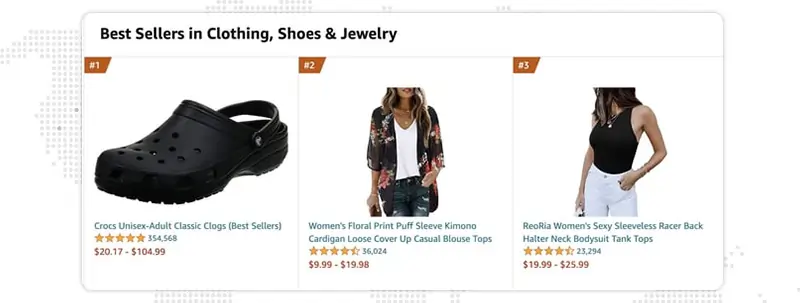
Unsurprisingly, apparel, footwear, and accessories are some of Amazon's best-selling items. Casual wear from Amazon Essentials is more popular than high-end labels with Amazon consumers.
There's a lot of competition in this space, so it's essential to stand out. On Amazon, customers aren't looking to drop a lot of cash on name brands but rather to save money. So, if you want to sell apparel, footwear, or jewelry, ensure it is of good quality at a reasonable price.
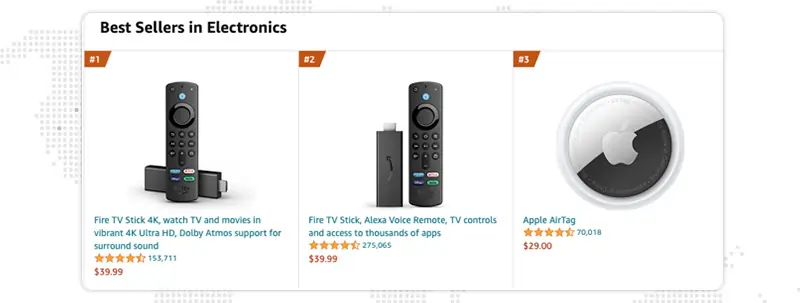
Customers are always looking for the newest and greatest in technology, whether it be computers, televisions, surveillance equipment, or wearables, which is particularly true of online retailers. Online sales now account for nearly half of all computer and electronics revenue.
Many people prefer to make their electronic purchases on Amazon because of the platform's constant low prices on some of the most sought-after items in the world. This might be a good niche to enter as a third-party seller if you can purchase electronics in large quantities.
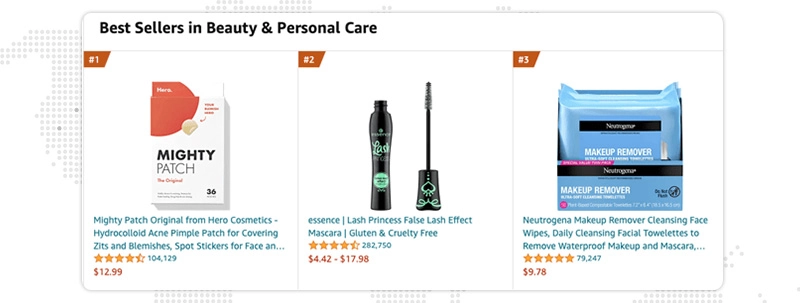
The Beauty and Personal Care section includes makeup, skincare, perfumes, and haircare. While there is a lot of competition in the cosmetics industry, those focusing on making sustainable and organic products may succeed.
It’s hard to find products to sell on Amazon or any other sales channel. However, some common characteristics are generally found in items that perform well. Here are some of the traits you should look for:
The physical dimensions and weight of your products play a big role in the order fulfillment process. Larger and heavier items require a more complex delivery process and will result in higher fulfillment fees. As a general rule, try to find items below 18” x 14” x 8” in size and 5 lbs in weight.
When searching for a product idea for your eCommerce store, it’s important to consider both the demand for the product and how competitive the market is.
Naturally, you want a product with high demand. This means that there are a lot of customers in the market for that item, increasing the amount of sales you can generate.
A product’s competition will determine how many of these potential customers you can turn into sales. The higher the competition is for a product, the more difficult it will likely be to earn a significant amount of sales.
As such, you should look for product ideas with relatively low competition Finding products to sell on Amazon with both high demand and low competition can be tricky. Fortunately, some of the tools we’ll discuss later on can help make it easier.
It goes without saying that the amount you pay to source a product will directly impact how profitable it is. Look for items that you can sell for at least four times the cost of procurement. For example, if the market price for a particular item is $10, make sure you can source it for $2.50.
This is important as you need to consider all the costs associated with selling physical products. In the example above, you would earn a gross margin of $7.50 per product sold. This doesn’t take into account operating costs like fulfillment and any marketing costs to acquire your customers.
If your product costs are 50%+ of the sales price, you would have trouble earning significant profits.
Next, you want to evaluate a product’s nominal sales price. A high percentage margin is nice, but if the nominal amount per sale is low, you will need to have considerable sales to earn solid profits.
Look for items that you can sell for around $10 - $70. This will ensure that you can earn a decent amount for every sale. By keeping within the top of this range you’ll also avoid higher ticket items which usually have less demand.
Commodities and other regularly used products are a reliable option for products to add to your store. These items are easy to source whether through wholesale or manufacturing. They are also replenishable, meaning customers need to buy them on a recurring basis.
This will give you a great opportunity to increase your customer lifetime value by driving repeat purchases from your loyal buyers.
When you start Amazon selling, you probably have a long list of things you want to offer. But how do you determine which one will yield the greatest financial rewards? To answer how to get products to sell on Amazon, you must conduct extensive product research to identify promising offerings.
Using a data-driven Amazon keyword research tool should be your first move when determining what to sell on the platform. Through this method, you can ascertain the level of interest in a given product and decide the most profitable product to sell on Amazon.
In the past, trying to uncover how many searches a term receives on Amazon would have been a difficult feat. But today, there are several powerful tools available dedicated specifically to Amazon keyword research.
With these tools, you can quickly assess the overall search volume of a keyword and how its use is trending over time.
For example with the AMZScout Keyword Research tool, you can enter a search term to find a list of all related search phrases used on Amazon. The list includes the estimated monthly search volume, the most popular category for products ranking for the keyword, and the PPC bid.
As an Amazon services agency, we leverage our expertise in product listing optimization, PPC campaigns, and inventory management to help our clients maximize their sales and revenue on the Amazon platform.
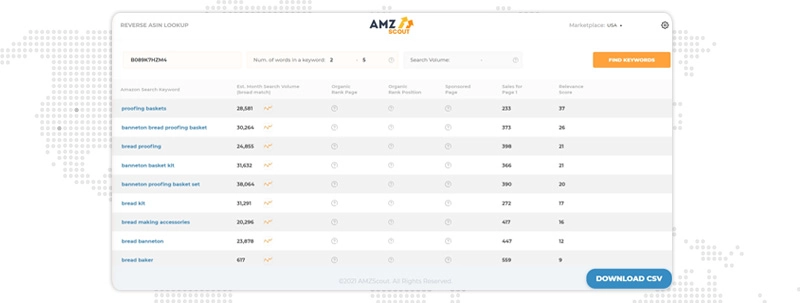
You can drill down into any search term to see high-performing Amazon products that have the keywords in the product title. This will provide you with the price and estimated revenue for each item so you can quickly gauge the profitability of this type of product.
You should pick low-competition keywords that will activate product advertising on Google to increase sales of your Amazon product.
You'll need to research to identify these low-competition terms before using them effectively on Amazon.
Putting yourself in the customer's shoes when deciding what products to buy to resell on Amazon is essential. Focus groups are a great way for vendors to hear directly from customers about what they like and don't like about a product if they have the time and resources. However, not all merchants will benefit from this.
Amazon customer reviews are a quick and cheap method to determine which products to sell on Amazon business.
It's important to read the product reviews if you're considering selling on Amazon business.
Exploring Amazon evaluations is a great way to see what customers like and dislike about a product. You can use that data to inform your choices about what to offer and whether or not to alter the product in any way.
Since you'll be selling on Amazon business, it's a good idea to investigate the products that have already proven popular among other vendors. The Best Sellers area of Amazon displays the most popular items in a given category, such as toys, games, or electronics.
To maximize your sales on Amazon, knowing what products have historically done well there is important.
If you are wondering how to find a product to sell on Amazon, this tool is your savior.
Searching Google for trending topics can help you zero in on goods that will sell, like hotcakes on Amazon.
Looking at what people buy on Google Searches, you can understand what will sell. Regardless of your intended market, Amazon is the place to offer your product. By perusing the most recent data from Google Searches, you can get a feel for what's selling best across many different markets.
You can narrow down the best products to sell on Amazon using the popular research tool Google Trends.
You can also take the help of an e-commerce development company to help you get started. Our company specializes in ecommerce website development, helping businesses create a seamless online shopping experience for their customers.
Amazon provides sellers with a wealth of customer data that can be used to inform their product selection strategies. Explore the Best Sellers section to access a complete list of goods ranked from 1 to 100. The items at the top of the Best Selling lists are the most popular in their respective categories, whether the broad "best seller" category or a more narrow "niche" category.
Aim for a profit margin of at least 50% whenever you add a new product to your inventory, especially if you are just starting out in eCommerce and third-party marketing. In this manner, you can safeguard your profitability regardless of whether your initial sales are modest or substantial.
When calculating your profits, consider the product's size, weight, and shelf life. Shipping costs can significantly affect your profits, especially for bulky or heavy products. In addition, you should consider how quickly a product will lose its novelty, fall out of favor, or be superseded by a revised model. This way, you won't be caught with a surplus of inventory and no buyers to absorb it if demand unexpectedly drops.
If there are already one hundred thousand hits in a search engine for the product you're trying to sell, it will be very hard to rise above the noise and get the sales you're after. Fortunately, it's not hard to locate a specific subset of a bigger market with less competition and where your product will rank higher in search engine results. Because they needed to conduct a more targeted search, the people who find your goods through that search are more likely to be interested in making a purchase.
Recent and past sales are considered when determining an item's position in Amazon's Best Sellers Index (BSR). If the BSR is high, people are interested in buying the merchandise.
This means that if there is only one product in a group with a high BSR and none of the others are best-sellers, it may be because that one product is completely cornering that market. You should instead focus on the product categories that already have multiple products with a high BSR, as this indicates demand and leaves space for your product to succeed.
As an Amazon services company, we provide comprehensive solutions for businesses looking to sell their products on the world's largest online marketplace, including account setup, inventory management, and advertising optimization.
The first way to find profitable products is to use the Amazon Trend Report. Every year Amazon analyzes what products have been popular across the internet over the previous 12 months. They then compare that information with what is currently popular on Amazon to curate a list of recommendations to include in the Amazon Trend Report.
In the report, you’ll find high-performing products for the niche(s) Amazon has selected which you can use as a starting point for finding products for your store.
If you want to take a more data-driven approach to finding profitable products on Amazon, there are a variety of product research tools at your disposal. These tools provide a comprehensive database of all the products listed on Amazon. You can search for specific items based on the criteria you define. Once you have a refined list of potential products, you can analyze your options to find the best matches for your business.
An example of one of these tools is the AMZScout PRO Extension. After you download the Chrome extension you can go to any product on Amazon to see detailed product research for that item.
Below is an example of the report for a bread-proofing basket.
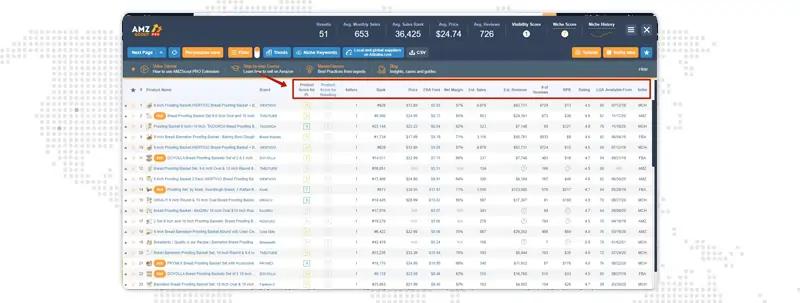
Amazon is a powerful tool for finding profitable product ideas for your eCommerce store. By utilizing Amazon's search bar, product categories, and reviews, you can discover in-demand products with a high potential for success in your niche. It is important to conduct thorough research on product pricing, competition, and profitability to ensure that your product selection will generate revenue and meet your business goals.
Additionally, it's essential to differentiate your products and create a unique Amazon selling proposition to stand out in the marketplace. With Amazon's vast database and the right strategy, you can find profitable product ideas and build a successful eCommerce business.
If you are a newbie or struggling to establish your niche in the market, you can take the help of our e-commerce web design agency. We offer a wide range of e-commerce website services, including design, development, maintenance, and digital marketing, to help businesses establish a strong online presence and drive sales.
Interested in our eCommerce Web Design & Development Services?

1. How to find profitable products to sell on Amazon?
Look at the product's pricing, demand, and competition to determine its profitability. You can also use tools like Jungle Scout to analyze a product's potential profitability more in-depth.
2. How to find items to sell on Amazon?
Look for gaps in the market, identify products with low competition, and research trends in your niche to find unique product ideas.
3. Can I sell the same products as my competitors on Amazon?
Yes, you can sell the same products as your competitors on Amazon, but you need to differentiate yourself through branding, pricing, or customer service to stand out and attract customers.
4. Is it necessary to have a niche to find profitable product ideas on Amazon?
While having a niche can make it easier to find profitable product ideas, it's not necessary. You can also look for products with high demand and low competition in broader categories.
5. How many product ideas should I consider before choosing one to sell on Amazon business?
It's recommended to consider at least 10-20 product ideas before choosing one to sell on Amazon. This will give you a better understanding of the market and help you make an informed decision.
f
Thanks for sharing such valuable blogs.
A
Thanks, these are great tips.
T
Interesting ideas
B
Thanks for sharing the suggestions
C
Loved reading it
F
Nice blog!